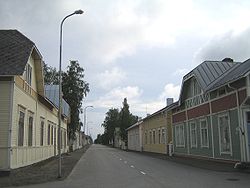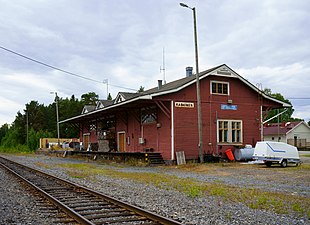-
Kaskinen Library
-
Kaskinen Church
-
King Gustav Square (Finnish: Kuningas Kustaan aukio)
-
Old freight station of Kaskinen
-
Sälgrund Lighthouse
Kaskinen
| |
|---|---|
Town | |
| Kaskisten kaupunki Kaskö stad | |
 Kaskinen | |
 Location of Kaskinen in Finland | |
| Coordinates: 62°22′N 021°15′E / 62.367°N 21.250°E | |
| Country | |
| Region | Ostrobothnia |
| Sub-region | Sydösterbotten |
| Founded | 1785 |
| Government | |
| • Town manager | Markku Lumio |
| Area (2018-01-01)[1] | |
| • Total | 175.36 km2 (67.71 sq mi) |
| • Land | 10.64 km2 (4.11 sq mi) |
| • Water | 164.87 km2 (63.66 sq mi) |
| • Rank | 312th largest in Finland |
| Population (2023-12-31)[2] | |
| • Total | 1,208 |
| • Rank | 286th largest in Finland |
| • Density | 113.53/km2 (294.0/sq mi) |
| Population by native language | |
| • Finnish | 58.8% (official) |
| • Swedish | 27.5% (official) |
| • Others | 13.7% |
| Population by age | |
| • 0 to 14 | 11.2% |
| • 15 to 64 | 47.1% |
| • 65 or older | 41.7% |
| Time zone | UTC+02:00 (EET) |
| • Summer (DST) | UTC+03:00 (EEST) |
| Unemployment rate | 65% |
| Website | www.kaskinen.fi |
Kaskinen (Finnish: [ˈkɑskinen]; Swedish: Kaskö) is a town and island in Finland, located on the west coast of the country. Kaskinen is situated in Ostrobothnia, along the Gulf of Bothnia. The population of Kaskinen approximately 1,000, while the sub-region has a population of approximately 17,000. It is the 286th most populous municipality in Finland.
Kaskinen covers an area of 10.64 km2 (4.11 sq mi) (excluding sea areas) of which 0.16 km2 (0.062 sq mi) is inland water (1 January 2018).[1] The population density is 113.53/km2 (294.0/sq mi).
Kaskinen is a bilingual municipality with Finnish and Swedish as its official languages. The population consists of 59% Finnish speakers, 27% Swedish speakers, and 14% speakers of other languages, which is well above the national average.
Kaskinen is the smallest municipality in Finland with town status.[6][7] The town is located on an island with two bridges to the mainland, and its only border neighbor is the town of Närpes. The townscape of Kaskinen consists of uniform wooden construction.[7][8] Even though it is planned mainly as a port town, the Suupohja Railway also runs from the town to the Ostrobothnian Railway to Seinäjoki. Today, however, the railway is only used for freight traffic, mainly for the Port of Kaskinen.[9]
The paddle appearing in the coat of arms of Kaskinen describes the excellent natural harbor that has influenced the establishment of the town in its place. The laurel leaf may have been intended to refer to flowering, but its origin may also be in the name of the Bladh family (Swedish: blad, "leaf"); Two members of the family – father and son – acquired both city rights and township status for the village at that time. The coat of arms has been redrawn by A. W. Rancken (1880–1954) based on the old coat of arms, which was originally confirmed on 9 April 1793.[10][11]







